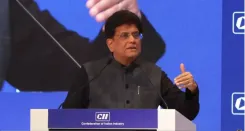Is India Boosting Fertiliser Production and Moving Away from China?

Synopsis
Key Takeaways
- India is increasing fertiliser production in response to halted supplies from China.
- The industry is projected to grow at a CAGR of 4.2%.
- A five-year agreement with Saudi Arabia secures DAP imports.
- Advanced technologies are driving innovation in production.
- Collaboration among stakeholders is critical for addressing challenges.
Mumbai, July 28 (NationPress) Following the cessation of essential fertiliser shipments from China, Indian manufacturers are ramping up their domestic production using cutting-edge technologies and new formulations, as reported on Monday.
The fertiliser sector in India is projected to expand at a CAGR of 4.2%, potentially reaching $16.58 billion by 2032.
In FY25, total fertiliser production rose to 51 MT, bolstered by key initiatives such as PM-KISAN and PM-Garib Kalyan Yojana, according to CareEdge Ratings.
Due to the restrictions on rare earth elements, China suspended its exports of speciality fertilisers and vital phosphate to India. In response, India has negotiated a five-year deal with Saudi Arabia to import 3.1 million tonnes of Di-ammonium phosphate (DAP) per year, covering about 30 percent of its domestic needs.
“This situation opens a unique opportunity. With China halting its fertiliser exports, Indian manufacturers are filling the void by enhancing domestic production, which will not only benefit them but also stimulate innovation, particularly through the incorporation of advanced technologies and the creation of new formulations,” stated Priti Agarwal, Senior Director at CareEdge Ratings.
“Policymakers, producers, and farmers are working together to address the challenge through a blend of alternative sourcing, local manufacturing, and practical innovation,” she added.
In recent years, China represented almost 70 percent of India’s speciality fertiliser imports from June to December. Now, India is making a significant shift towards supply diversification and increased resilience by investigating alternatives such as Saudi Arabia, Israel, Jordan, Russia, Oman, and Morocco.
Chinese DAP shipments to India began declining in 2023, plummeting from 2.29 MT in FY24 to 0.84 MT in FY25, with no shipments since early 2025.
Inspection clearances for DAP and speciality fertiliser shipments to India have been suspended since April 2025, blocking supplies while exports to other countries continue.
“Maintaining adequate inventory and ensuring timely distribution—through coordinated efforts between the government and private stakeholders—should be the immediate focus. The recent agreement with Saudi Arabia for long-term DAP supply is a timely measure in this regard,” remarked Sachin Mathur, Associate Director at CareEdge Ratings.










